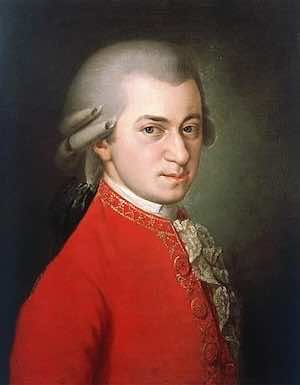Top > Musicians Related to C.P.E. Bach > Mozart
This site introduces unknown composer Emanuel Bach (C. P. E. Bach). This English version was translated from Japanese one by ChatGPT.
Wolfgang Amadeus Mozart
ChatGPT4o writes as follows (please note that it may not be accurate):Wolfgang Amadeus Mozart (1756–1791) was a composer from Austria and a genius representative of Classical music. He displayed extraordinary talent from a young age and left numerous masterpieces across various genres. His music is known for its melodic beauty, structural perfection, and profound emotional expression.
Mozart was born in Salzburg and, under the guidance of his father Leopold Mozart, demonstrated his talent for composition and performance early on. From a young age, he traveled extensively across Europe on concert tours, absorbing various musical styles. From 1777 onward, while working as a court musician, he aimed to establish himself as an independent composer.
His body of work is vast, covering nearly every genre, including 41 symphonies, operas, piano concertos, chamber music, and sacred music. Particularly, his operas such as *The Marriage of Figaro*, *Don Giovanni*, and *The Magic Flute* are highly acclaimed for their perfect fusion of music and drama. His instrumental works, including piano concertos and symphonies like No. 40 and No. 41 (*Jupiter*), are also celebrated masterpieces.

Mozartʼs music is characterized by genius melodies, innovative harmonies, and intricate structures. Moreover, he excelled in deeply expressing diverse emotions such as joy, sorrow, and prayer.
Although he established his career primarily in Vienna, Mozart struggled with financial difficulties and health problems in his later years. He died in 1791 at the young age of 35. His *Requiem*, composed just before his death, remains unfinished and continues to be shrouded in many mysteries.
Mozartʼs music is regarded as the pinnacle of Classical music and greatly influenced Beethoven and later Romantic composers. Its universal beauty and emotional depth continue to captivate people across generations.
"While Haydnʼs symphonies are mostly in four-movement form, Mozart, who learned from Haydn and the Mannheim school, composed many symphonies with three movements. Why is that?"
There are several factors that may explain why Mozart composed many three-movement symphonies. Below is a detailed explanation of those reasons.
Historical Background and Stylistic Transition
- Developmental Stage of the Symphony:
- When Mozart began his compositional career, the symphony was still evolving, and the three-movement form (fast-slow-fast) was common. Many of his early symphonies followed this tradition.
- Italian Influence:
- During his youth, Mozart traveled to Italy, where he was greatly influenced by the local music. Italian symphonies and overtures (*sinfonias*) were typically composed in three movements, which impacted his early works.
- Patron Demands:
- Composers at the time often wrote music according to the demands of patrons such as nobility, the church, or theaters. Patrons frequently preferred shorter, more dazzling works, and Mozart provided compositions to meet those preferences. Particularly for theater or celebratory music, shorter symphonies were often required.
Personal Compositional Style and Experimentation
- Experimentation with Form:
- Mozart constantly explored new forms and styles. While he continued to compose three-movement symphonies, he also engaged with four-movement forms, introducing many innovations. His symphonies show a flexible approach to traditional forms.
- Purpose of the Works:
- Many of his three-movement symphonies were written as opera overtures or other theater music. These pieces were short and effective, suitable for performance before a play or during intermissions, making the compact form desirable.
Specific Examples
- Symphony No. 29 in A Major (K. 201):
- This symphony is in four-movement form, but many of Mozartʼs early symphonies are in three-movement form. Observing the evolution of his symphonies, early works often had three movements, while later works predominantly adopted four movements.
- Symphony No. 25 in G Minor (K. 183):
- This symphony is also in four-movement form, yet many of his early works remained in the three-movement format. Mozart flexibly chose forms based on the situation and demands.
Conclusion
The reasons Mozart composed many three-movement symphonies stem from the transitional symphonic forms in his early career, the influence of Italian music, the demands of patrons, and his experimental approach. He maintained a flexible attitude toward form, selecting either three- or four-movement structures depending on the context and purpose. Ultimately, Mozartʼs later symphonies predominantly followed the four-movement form, which became the standard format for Classical symphonies.
Site search by Google
Upper< Lower> items
< Musicians Related to C.P.E. Bach> Alternative Names for Johann Christian Bachʼs Galant Style?
> Christian Bach and Mozartʼs “La clemenza di Tito”
> Commissioned and Exploratory Compositions
> Comparison of Haydnʼs and Johann Christian Bachʼs Influence on Mozart
> Mozart and C.P.E. Bach
> Mozart and Christian Bach
> Mozart and Haydnʼs Three-Movement Symphonies
> Mozartʼs Employment
> Mozartʼs Operas
> Ritornello Form in Haydn and Mozart
> Symphony Composition Years and Age
> The Conflict Between Amadeus Mozart and His Father Leopold in Salzburg
> The Influence of Christian Bachʼs Operas on Mozart
> The Influence of the Mannheim School on Mozart
> The Influence on Mozartʼs Symphony No. 9
> The Relationship Between Haydn and Mozart
> The Relationship Between Hummel and Chopin is Similar to That Between Christian Bach and Mozart
> The Use of Dissonance – Mozart, Monteverdi, and Others
> Use of Counterpoint in String Quartets
> Using Counterpoint in Later Years